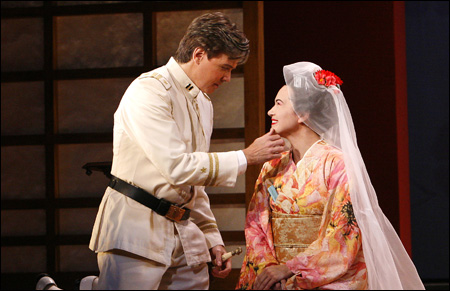
MADAMA BUTTERFLY: Kelly Kaduce caught fire only in Cio-Cio-San’s final scene. |
The most extraordinary event at last week’s extraordinary Boston Symphony Orchestra concert was the one the fewest people heard. For the BSO’s ongoing Beethoven-Schoenberg series, James Levine paired the Schoenberg Violin Concerto with the Beethoven Violin Concerto and added a string-orchestra arrangement of Beethoven’s Große Fuge (“Great Fugue”: the original finale of his 13th String Quartet, an uncompromising 17-minute movement he later replaced with a shorter and simpler movement). The extraordinary part was performing the Große Fuge twice, at the beginning of the concert and then again at the end, so you could hear it in relation to both violin concertos.
When you heard it first, it sounded much the way you might expect it to: knotty, relentless, a perpetual-motion dance of death with two lighter interludes. The second time it sounded lucid, æthereal, an oasis of peace and order. Not because it was played any differently. Of course, after Schoenberg’s heavier demands, it came as a relief, a breath of air. But you could also hear how it fed into Schoenberg’s ideas about structure and tonality. Not only could you understand it better in itself, but it helped you understand the Schoenberg you’d just heard.
I was wondering before the concert started how many in the audience would flee after the two Beethoven pieces. There were certainly more empty seats after intermission, and even more after the first movement of the Schoenberg. But the largest exodus occurred at 10:04, just before the repeat of the Große Fuge. I guess a lot of people thought they were going to hear the same piece twice.
So far in Levine’s Beethoven-Schoenberg survey I’ve been much happier with his Schoenberg than with his Beethoven. But the Beethoven this time was more convincing and powerful. The Große Fuge was the best live performance of the orchestral version I’ve ever heard. The antiphonal seating (first and second violins on opposite sides of the stage) that Levine has brought to the BSO allowed you to hear the four separate interweaving voices of the fugue. Anyone who arranges orchestral versions of string-quartet movements must decide whether to include basses, and if so, where to put them. Levine based his transcription on Beethoven’s own two-piano arrangement of the piece, which he had evidently studied in depth. Where he added basses to support the cellos gave the low end of the scale visceral force; at one point the sound was so deep I wondered whether any cellos were playing at all. All the strings played with precision, and the slower, higher-lying passages had a celestial weightlessness. The orchestra not only met the technical challenge but also presented an emotional trajectory. The last bars were the most celebratory moments of the evening.
The soloist for the two concertos was the 40-year-old German violinist Christian Tetzlaff, whose playing of the Ligeti Violin Concerto under Franz Welser-Möst in 1997 was one of the BSO’s most memorable performances of 20th-century music. Tetzlaff is not just a commanding technician, he also has a probing musical mind. The Beethoven concerto was never soupy, merely throbbing with vibrato. It was always freshly phrased — infectiously lean and buoyant, urgent and intimate. (Some of the BSO string players were irresistibly bobbing and swaying while Tetzlaff played.) The big surprise came in the big first-movement cadenza, that moment when soloists take off on their own. This one was composed by Tetzlaff, and it was less a solo than a duet with BSO timpanist Timothy Genis. The concerto itself opens with four drum taps, and they become a running motif. Drum taps are also significant in the Schoenberg, so Tetzlaff’s cadenza became one more way of pulling the entire program together.